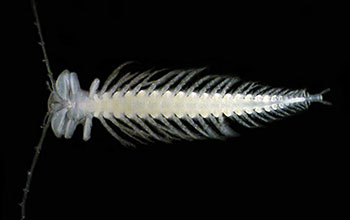Multimedia Gallery
Studying Life in Underwater Caves (Image 2)
This species of remipede, Pleomothra fragilis, newly described in 1989, was found in Oven Rock Cave in the Exuma Cays, Bahamas.
Remipedes are a primitive class of crustacean believed to be one of the oldest crustacean groups on Earth, possibly dating back 200 million years to the time of the dinosaurs. Remipedes look similar to centipedes and have hollow-tip fangs for injecting venom. They are hermaphrodites.
This picture was taken by Thomas Iliffe, a professor of marine biology at Texas A&M University at Galveston. Iliffe was awarded a grant by the National Science Foundation in 2003 to study anchialine caves in the Bahamas (grant DEB-0315903). Anchialine (a Greek word meaning "near the sea") caves are coastal and form in limestone or volcanic rock. They flood with seawater and include the longest submerged caves on Earth. Many previously unknown species of higher taxa live in these caves. Most do not have eyes or pigment since they live in perpetual darkness.
To learn more, see the Texas A&M news story Texas A&M marine experts take discoveries to new underwater heights; or visit Iliffe's website, Here. [Ref. Koenemann, S. M. Ziegler and T.M. Iliffe (2008). Pleomothra fragilis n. sp. (Remipedia) from the Bahamas, with remarks on morphologic reductions and postnaupliar development. Journal of Crustacean Biology, 28(1):128-136.] (Date of Image: 2008) [Image 2 of 5 related images. See Image 3.]
Credit: Thomas M. Iliffe, Texas A&M University at Galveston
Images and other media in the National Science Foundation Multimedia Gallery are available for use in print and electronic material by NSF employees, members of the media, university staff, teachers and the general public. All media in the gallery are intended for personal, educational and nonprofit/non-commercial use only.
Images credited to the National Science Foundation, a federal agency, are in the public domain. The images were created by employees of the United States Government as part of their official duties or prepared by contractors as "works for hire" for NSF. You may freely use NSF-credited images and, at your discretion, credit NSF with a "Courtesy: National Science Foundation" notation.
Additional information about general usage can be found in Conditions.
Also Available:
Download the high-resolution JPG version of the image. (524 KB)
Use your mouse to right-click (Mac users may need to Ctrl-click) the link above and choose the option that will save the file or target to your computer.



